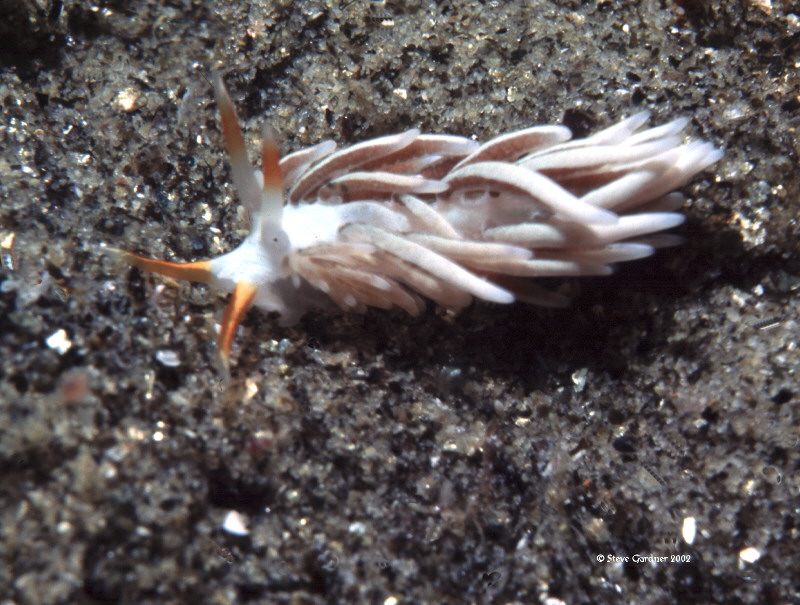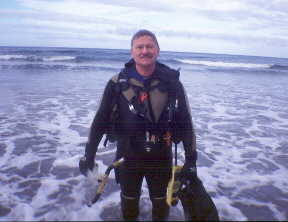 |
Cuthona columbiana
Photo courtesy of Steve GardnerLa Jolla Shores
Sept. 2002
Cuthona columbiana (O Donoghue, 1922)
Wow.... here's a find. Steve's shot above was taken at La Jolla Shores, San Diego, CA the very southern most documented point in this species geographic range. This is a northern species as noted by its name "columbiana", for British Columbia where the species was first described from.
C. columbiana is recognized by its orange rhinophores and cephalic tentacles and the smooth white lines down the cerata. You can see the line in Steve's photo, above the brown core of the cerata. It has recently been confused with Cuthona punicea . See Bill Rudman's Forum for a discussion of the differences . Bottom line is that C. punicea does not have any orange on rhinophores and cephalic tentacles.
C. columbiana has had a bouncy taxonomic past. In Pacific Coast Nudibranchs , page 89, I used the name Catriona columbiana . Most now follow Miller (1977) in his review of tergipedid aeolids of New Zealand and replace the genus name Catriona with Cuthona . Subsequent to its original description it was named twice as Cuthona alpha and Cuthona spadix. Both of these names are now considered junior synonyms.
The species is quite common in British Columbia, but is rarer at the southern end of its range. Specimens have been collected as far north as Ketchikan, Alaska. This species feeds on hydroids such as Tubularia .
Reference:
Miller, M.C. 1977. Aeolid nudibranchs (Gastropoda: Opisthobranchia) of the family Tergipedidae from New Zealand waters. Zool. J. Linn. Soc. 60(3):197-222, pl. 1.
Dave Behrens
Danville, CA
Nov., 2002
Steve Gardner at La Jolla Shores (his backyard)

Steve "bumble bee" Gardner as he is known to the regulars at La Jolla Shores was already a veteran diver/photographer when I joined the San Diego Underwater Photographic Society back in 1982. Steve has enjoyed great sucess with the Nikonos system he was using then and still is using now. California diving at times can be quite challenging with cold water and surge. " Washing machine " like water conditions almost make digital photograhy impossible and film photography marginal at best with a housed SLR, can be overcome by using framers! Using framers with a Nikonos was the solution for Steve then and still is the solution under such conditions. So don't despair all you aspiring U/W photographers! When confronted with the high cost of going with a housing either digital or film, you may want to consider looking for a used Nikonos with framers. Pick up an inexpensive strobe to go with it and you're in business at what can be a very reasonable price. Steve can usually be found diving at the Shores on the weekend but if you can't make it, you might want to visit his photo gallery to see all the unique animals Steve has photographed through the years.-Webmaster |

David W. Behrens
Author:
Pacific Coast Nudibranchs
Send Dave mail at seachalleng@earthlink.net
|
